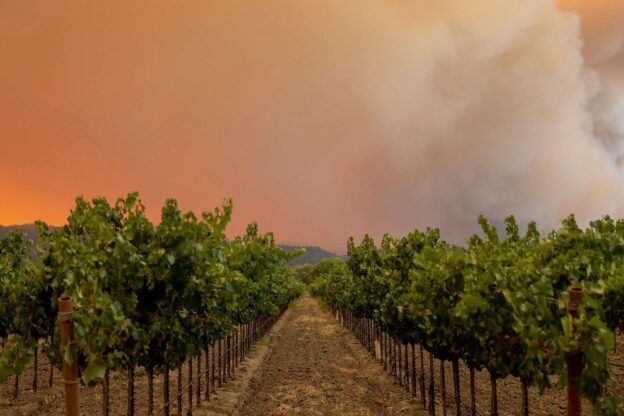It’s like deja vu all over again. In October 2017 we all watched in helpless horror as wildfires tore through northern California’s wine country, threatening lives, property and vineyards. In total, the fires killed 44 people that year. Then in 2018, California experienced the deadliest and most destructive wildfires on record, killing 85 people. Only two short years later, we are witnessing the same thing happening again.
Few industries have been as susceptible to the impacts of climate change as the wine industry. If you ask any grape grower they will tell you without hesitation that climate change is real and is having a substantial impact on their vineyards. For some, climate change may be positive. Vineyards in historically cooler areas are now warming up, allowing grapes to ripen more fully and consistently, leading to increasingly concentrated wines and more high quality vintages. It also means areas of the world that were once too cold for grape growing are now able to produce wine. Take a look at the delicious sparkling wines coming out of the UK.
However, many warm grape growing regions are now getting hotter and drier. You only have to look at the past three years to find raging wildfires in California and Australia, an intense multi-year drought in South Africa, and severe temperature spikes in Spain. These changes result in sunburned, damaged or destroyed fruit. Fruit that does survive can contain such high sugar levels that resulting alcohol can easily reach above 16% ABV, causing wines to taste jammy and flabby with an obvious alcohol burn and little nuance or flavor complexity.
Then there is the issue of smoke taint in regions that experience fire. The previous California wildfires occurred in the Fall after much of the grape harvest had already taken place, with wines safely stored away in barrels in cellars where they were protected from smoke. Not so this year. The current wildfires in California could not have occurred at a worse time for winemakers – right before harvest when the grapes are most susceptible to environmental influences.
It is obvious from the photos coming out of California of Mars-like orange skies and air thick with smoke, that some vineyards will have to deal with grapes infected by smoke taint. Smoke does not damage a vine in the long term as it doesn’t get into the roots or the soil. Rather, it is absorbed into the skins of ripening grapes, so it can’t simply be washed off. Smoke taint results in flavors in the wine described as burnt, ashy and medicinal. So what are wineries to do?
- The first thing is to assess the damage by conducting laboratory analyses on the grapes to determine the level of smoke taint in the fruit.
- If the smoke taint isn’t excessive, there are several options available to the winemaker:
- They can choose to produce white, rose or sparkling wines from the grapes. These wine styles are produced by quickly draining the juice off the grape skins prior to fermentation. By limiting contact with the skins, the juice will pick up fewer of those smokey volatile compounds.
- They can blend smoke-tainted batches of wine with batches that are not tainted. They can also over-oak the wine by adding oak flavoring. The idea is to dilute or mask the off-flavors in the tainted wine with the unaffected wine or oak flavoring.
- They can process the wine using reverse osmosis or similar methods. Reverse osmosis separates the components of the wine – water, ethanol, flavor, color, tannins, etc. Once separated, the tainted components of the wine can be removed and the remainder blended back together. This is not only an expensive process, but it’s also not always very effective.
- If smoke taint levels are too high, the above methods won’t work effectively. In that case, the producer may have no choice but to dump their entire vintage of wine. It may also be possible to sell the wine (usually at a financial loss) to be used in other products such as hand sanitizer. In some cases, the wine may be potentially sold to distilleries to produce spirits.
It is too soon to tell how affected West Coast vineyards will be due to the still raging wildfires, although many producers remain optimistic. Harvest is just beginning and it will take time to assess the damage and determine steps forward.





